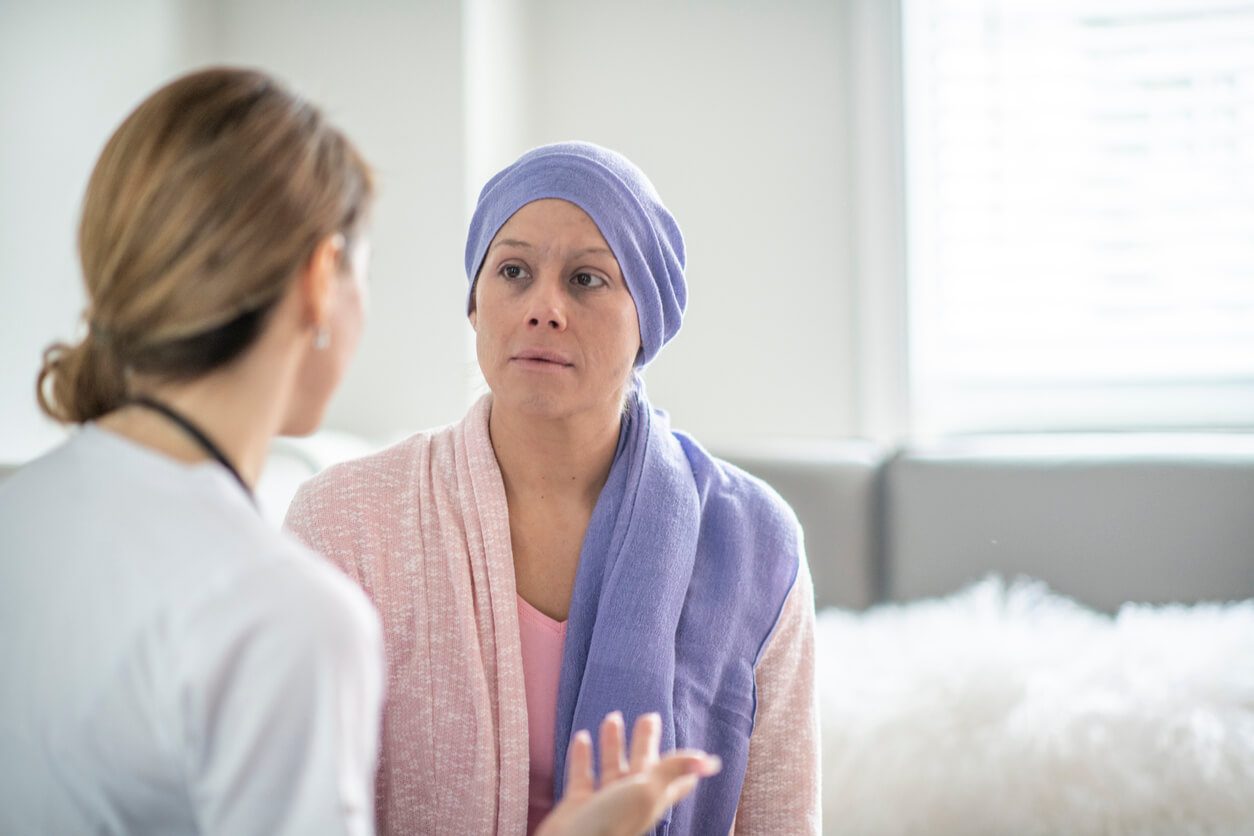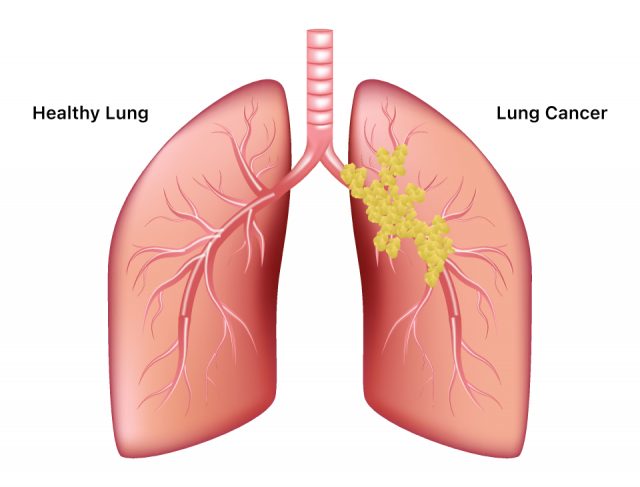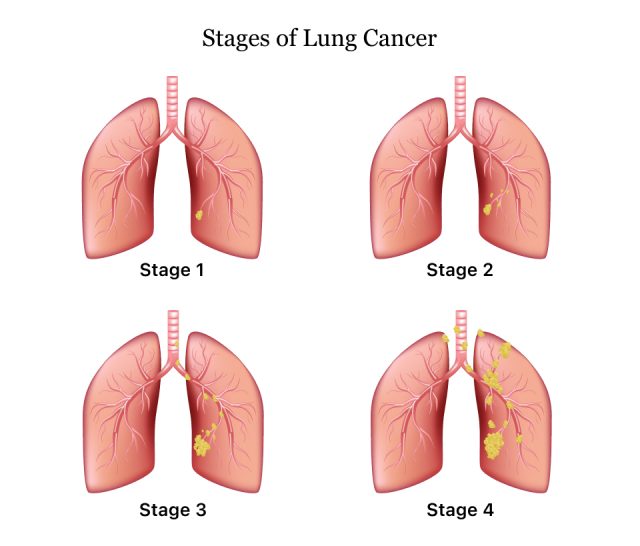Lung Cancer
Lung cancer begins in the lung and is most common in people who smoke. Common symptoms include chest pain, weight loss, coughing up blood and wheezing. Because of a decline in smoking, better detection and better treatment, death rates have dropped in recent years. This guide will help you understand lung cancer symptoms, diagnosis, staging, treatment and survival rates.

Lung cancer is the second most common cancer in women and men, and it’s the leading cause of cancer death, according to the American Cancer Society. The organization estimates there will be about 236,740 new cases of lung cancer in 2022.
People who are 65 or older are at the greatest risk for lung cancer, but in rare cases it may affect people younger than 45.
There are two main types of lung cancer: non-small cell lung cancer (NSCLC) and small cell lung cancer (SCLC). NSCLC is the most common type, and it makes up about 84 percent of all lung cancers.
Treatment options and survival rates depend on the type of lung cancer and how far the tumor has spread.
- About 84 percent of lung cancers are non-small cell lung cancer (NSCLC).
- Average age of lung cancer diagnosis is 70.
- Men have a 1 in 15 chance of getting lung cancer, and women have a 1 in 17 chance.
- Black men are more likely to get lung cancer than white men are, and they are more likely to get NSCLC.
- On average, NSCLC has a 25 percent five-year survival rate.
- On average, SCLC has a 7 percent five-year survival rate.
- Treatment for lung cancer includes surgery, radiation therapy, chemotherapy, immunotherapy and palliative therapy.

Symptoms
Most people don’t have lung cancer symptoms until the cancer has spread. But some people may notice symptoms. It’s important to talk to your doctor right away if you notice symptoms because lung cancer is easier to treat if caught early.
Many of these symptoms may be caused by other health problems, and it’s important to check with your doctor to rule them out.
- Chest pain that gets worse when coughing, laughing or taking deep breaths
- Coughing up blood
- Coughing up phlegm or spit that is rust colored
- Fatigue or weakness
- Hoarseness
- Loss of appetite
- Persistent cough that gets worse
- Recurrent respiratory infections such as pneumonia
- Trouble catching your breath
- Unusual weight loss
- Wheezing
Causes and Risk Factors
Lung cancer starts when lung cells change and mutate. A person’s lung cancer risk is influenced by breathing in toxic substances, genetics, family history or lung trauma.
Smoking is the biggest cause of lung cancer. In fact, about 90 percent of all lung cancers happen because of smoking, according to the American Lung Association. Tobacco smoke contains many toxic chemicals that damage the lungs. Even nonsmokers have an increased cancer risk if they breathe in secondhand smoke.
Make sure you tell your doctor about your family history, lifestyle habits, what you do for work and the medications you use. This information will help them determine your specific risk factors.
- Workplace exposure to chemicals such as asbestos, arsenic, chromium, soot, tar, beryllium or nickel
- Radiation therapy to the chest or breast
- Radon exposure in the home
- Getting CT scans
- Air pollution
- HIV infection
- Smoking and second hand smoke
E-Cigarettes
The science on e-cigarettes is still relatively new. While researchers agree e-cigarettes have fewer health risks than smoking, vaping is not risk free.
Studies have shown that young people who vape are more likely to smoke tobacco cigarettes in the future, according to Moffitt Cancer Center. This in turn leads to a higher risk of developing lung cancer from cigarette smoking.
Chemicals contained in vaping liquids, also called e-juice, may increase the risk for lung cancer. One such chemical is acrolein. Acrolein is a weed killer and may cause lung cancer, lung injury, COPD and asthma, according to data cited by the American Lung Association.
Medications
Studies have suggested certain medications may increase lung cancer risk. Some of these are the weight loss drug Belviq (lorcaserin) and blood pressure medications in the ACE inhibitor class.
In February 2020, the FDA requested the withdrawal of Belviq from the U.S. market because a clinical trial showed an increased occurrence in cancer among the drug’s users. The most common cancers were pancreatic, colorectal and lung.
A 2018 observational study published in BMJ found ACE inhibitors such as Lisinopril, captopril and benazepril were associated with an increased risk of lung cancer compared to angiotensin receptor blockers such as losartan and valsartan.
Diagnosis
Doctors diagnose lung cancer by using a combination of physical tests, imaging tests and lab tests. First, your doctor will ask about your medical history and look for physical signs of health problems. If your doctor determines you need more tests they will order them.
These tests can look at potential areas in the body that might be cancer, help determine if treatment is working and see how far cancer has spread.
- Chest x-rays are typically the first kind of imaging test recommended by doctors, and if the results look suspicious, you may have more tests.
- CT scans take several x-rays of your chest and are more likely to show tumors than x-rays.
- MRI scans use radio waves instead of x-rays to look for tumors and can show if the cancer has spread to the spinal cord or brain.
- Bone scans use small amounts of radioactive material injected into the bone to check for cancer in the bones.
- Biopsies take small samples of lung tissue for pathologists to study in the lab.
- Sputum cytology uses samples of mucus coughed up from the lungs to look for cancer cells.
- Thoracentesis uses fluid collected from around the lungs to check for cancer.
- Ultrasounds are imaging tests used to check lymph nodes for cancer.
- Lung function tests involve patients blowing into a tube to measure how well the lungs are working.
Types and Stages of Lung Cancer
There are two main types of lung cancer: non-small cell lung cancer and small cell lung cancer. In general NSCLC is easier to treat than SCLC and has a better prognosis.
A cancer’s stage is based on the size of the tumor and how far it has spread. Each type has its own staging system.

Non-Small Cell Lung Cancer
NSCLC is the most common type of lung cancer, and it grows more slowly than SCLC. This type of lung cancer may occur in people who have never smoked.
- Adenocarcinoma is the most common type of NSCLC, and it starts on the outer sections of the lungs.
- Squamous cell carcinoma begins in the middle of the lungs in the bronchi.
- Large cell carcinomas grow quickly and may begin in any part of the lungs.
Staging for NSCLC
- Stage 0 – the tumor hasn’t grown outside of the lungs and is also called “in situ” disease.
- Stage I – the tumor is small and hasn’t gone into lymph nodes. Stage IA tumors are 3 cm or smaller in size, stage IB tumors are between 3 and 4 cm in size.
- Stage II – the tumor is between 4 cm and 5 cm in size and stage IIA tumors have not spread to lymph nodes while stage IIB tumors have spread to lymph nodes.
- Stage III – the cancer has spread outside of the lung to nearby structures and depending on the size of the tumor they are stage IIIA, IIIB or IIIC. These cancers are difficult or impossible to remove with surgery.
- Stage IV – the cancer has spread to more than one area in the other lung, into fluid around the lung or heart or distant body parts. NSCLC typically spreads to the adrenal glands, brain, bone and liver. Stage IVA has spread to 1 area outside the chest and IVB has spread outside the chest to more than one place or organ.
Small Cell Lung Cancer
SCLC is the most aggressive type of lung cancer and almost exclusively occurs in people who have smoked cigarettes. It has two types: small cell carcinoma and combined small cell carcinoma.
Staging for SCLC
SCLC has two stages: limited and extensive.
Limited stage cancer is on one side of the chest and might have spread to lymph nodes. It’s rarer to find SCLC in the limited stage.
Extensive stage cancer has spread widely through the lung or both lungs, through the lymph nodes on the other side of the chest and other organs or body parts. Two out of three people have extensive stage SCLC when it’s first found.
Lung Cancer Prognosis and Survival Rates
A prognosis is the chance that a patient will recover. Doctors use survival statistics combined with factors such as a patient’s age, cancer stage and the type of cancer to help determine a patient’s prognosis. A favorable prognosis means there is a good chance of treatment success.
Doctors typically use five-year survival rates to determine prognosis. These rates are examples of how likely it is that treatment will succeed once cancer has reached a certain stage. People whose cancer hasn’t grown past the lung are more likely to survive at least five years with treatment.
Survival rates vary drastically depending on the type of lung cancer a person has. Each person is different and these rates don’t take family history, genetics or risk factors into consideration. Talk to your doctor about your specific case.
- Overall survival rate – 25 percent
- Local (tumor hasn’t gone outside the lung) – 63 percent
- Regional (tumors have spread out of the lung into nearby organs or lymph nodes) – 35 percent
- Distant (cancer has spread to distant organs and parts of the body) – 7 percent
- Overall survival rate – 7 percent
- Local (tumor hasn’t gone outside the lung) – 27 percent
- Regional (tumors have spread out of the lung into nearby organs or lymph nodes) – 16 percent
- Distant (cancer has spread to distant organs and parts of the body) – 3 percent
Treatment
Doctors will determine a patient’s treatment plan based on the type and stage of a person’s cancer. They will also take into account a person’s general health and age. For example, some people with lung cancer might be too frail for surgery. In this case, the doctor will recommend radiation or chemotherapy.
NSCLC Treatment
Doctors will recommend surgery to remove lung tumors that haven’t spread outside of the lung. Surgery may be combined with chemotherapy and radiation therapy for more advanced cancers. Sometimes surgeons may recommend chemo and radiation before surgery to reduce tumor size.
Surgery isn’t a treatment used for lung tumors that are stage III and up because the cancer has spread too far.
Targeted therapy identifies and attacks specific cancer cells and may be less harmful than chemo or radiation. They work by stopping cancer growth and killing cancer cells. Three types of targeted therapy are mammalian target of rapamycin (mTOR) inhibitors, tyrosine kinase inhibitors and monoclonal antibodies.
Doctors may recommend immunotherapy, a type of therapy that helps the body’s immune system fight cancer. Drugs for immunotherapy are called biologics.
SCLC Treatment
Because SCLC is aggressive and often found after it has spread to more than one lung, surgery alone isn’t effective. Chemotherapy and radiation therapy are the most common treatments for SCLC.
Similar to treatment for NSCLC, doctors may also recommend immunotherapy.
Because SCLC is aggressive, it’s less responsive to current available treatments. National Cancer Institute recommends joining a clinical trial for more treatment options.
Prevention
Avoiding certain controllable risk factors may help someone prevent cancer. These include smoking, being overweight and diet.
- Don’t start smoking, and if you smoke, quit
- Avoid second hand smoke
- Practice safe sex and avoid HIV infection
- Minimize exposure to radiation and make sure you talk to your doctor about the risk of radiation from too many x-rays or CT scans
- Avoid exposure to carcinogenic chemicals in the workplace, these include asbestos, arsenic, beryllium, cadmium and tar and soot
- If you are a heavy smoker, avoid beta-carotene supplements
- Maintain a healthy weight and get exercise
- Eat a healthy diet
- If you have a family history of lung cancer, ask your doctor about lung cancer screening
Calling this number connects you with a Drugwatch.com representative. We will direct you to one of our trusted legal partners for a free case review.
Drugwatch.com's trusted legal partners support the organization's mission to keep people safe from dangerous drugs and medical devices. For more information, visit our partners page.

